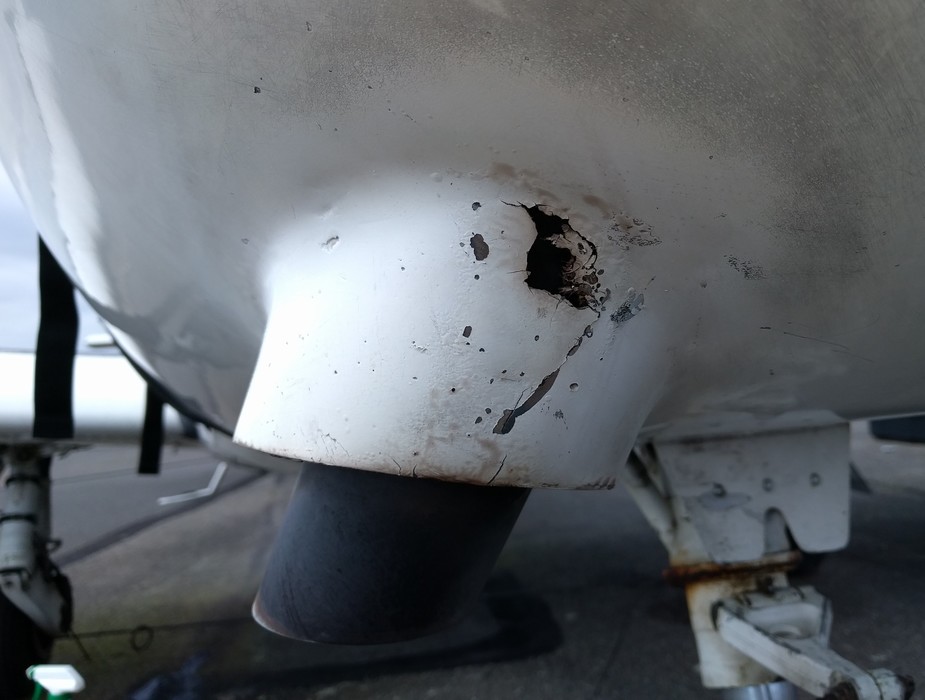This is the second time I have to repair this. During the last annual, my suspicion is that the mechanic only filled in the crack, and used sub-optimal heat resistant material, hence it cracked again at the same spot. The exhaust stack does not touch any part of the cowling, and is centered.
I like to ensure my A&P uses the proper resin. What resin is allowed to be used to fix a crack in the lower cowling at this location? Does it need to be high temperature resistant? Epoxy or Polyester? I can’t find anything in the TB20 manual that specifies it.
For heat resistant material I am considering FiberFrax.
Any tips appreciated. Thank you!

AFAIK Socata use standard fibreglass for their cowlings.
A few years ago I replaced all the quick-release fasteners (put in the better quality “MILSPEC” ones from the USA) and the material seemed standard.
From memory, there is some reinforcement around where the exhaust comes out.
@A_and_C is a fibreglass specialist and he may have an input. If it was me, I would repair it with glass matting bonded with a high temperature epoxy resin.
The first thing is filling the crack simply won’t work as the bonding area is not sufficient to take the load.
I have not been asked to fix a SOCATA cowl but assume it is epoxy.
The area needs scarffing out to get the bonding area to a size that will take the loads ( atleaset to 7-1). The chances are before doing this you may need to make former of the area using an un damaged cowl to ensure the repair retains the original shape.
Some investigation of the original cloth lay up will be required to ensure his can be replicated.
The repair will have to be cured at atlease 60 C for a minimum of twelve hours and 80 C for a further eight hours for maximum strength. ( this is a general rule but see the resin manufacturers data for precise heat times ).
Fiberfax or whatever it is called is not the answer, the original spec cloth is what you need.
As you can see there is a lot more to this than slapping a bit of wet fibreglass mat over the hole.
The skills to fix this properly are almost imposable to find in the metalcentric GA business as demonstrated by your mechanic, I would recommend you seek a glider repair shop, they will have the skills to do this job properly.
This is a non structural repair. Any boat shop could fix this so it last. On the inside I would put some reflective mat and/or insulate the pipe. Then it will never happen again.
The higher the temperature rating of the epoxy, the higher the cure temperature. At work we have an ultra high strength application requiring 120 C continuous service and the resin we spec has IIRC a 160 C cure temp. I’m inclined to doubt Socata used anything requiring an elevated temperature cure but I could be wrong. If you do need slightly elevated temp, it can often be achieved with an electric heater blanket.
The initial repair will be fairly simple work. Grind back as A & C says, normal practice is to grind back at a 10:1 angle. If the cowling is made of cloth, use that versus matt. Each layer of cloth should be slightly larger than the layer below so that the edges are all covered except for the last layer.
The neat thing about non-structural fiberglass work is that the part is infinitely repairable. If for some reason you don’t like the repair, you can grind it out and start again. Older motorcycle bodywork that was made in the same way as this cowling (i.e. mid-90s and earlier, before plastic) parts can literally be reassembled from several pieces, with perfect results: you initially jig the parts with Popsicle sticks and bondo, later removed.
High temperature cure is only for maximum strength, no?
I use some stuff like that. Loctite IIRC. Works great without curing.
Primary structure requires the 60/80 C cure cycle non critical structure requires only 60 C to cure.
technically cowlings are not primary structure but but due to the loads that cowlings take I would recommend the full 60/80 C cycle.
Thank you all! I was told the original resin was 356 PA. I have no experience with resins. What temperature resistant epoxies exists that can be used to repair this?
Today I found an interesting article here …. http://www.avweb.com/news/features/Heat-Shields-for-Homebuilts-226228-1.html